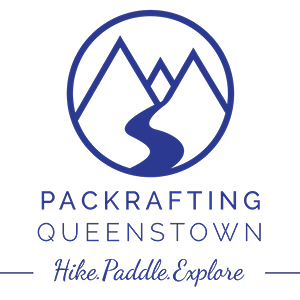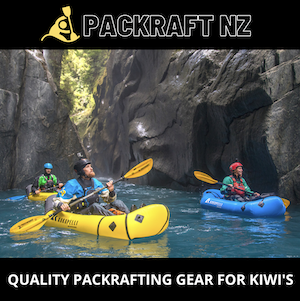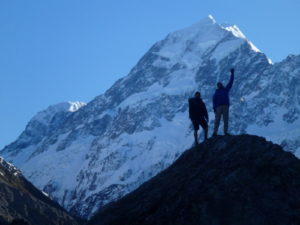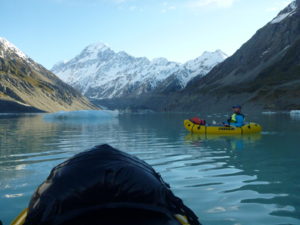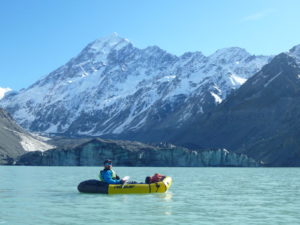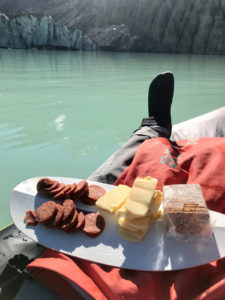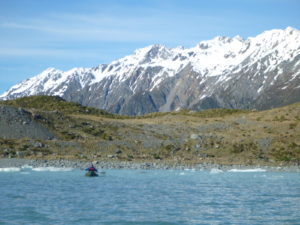A half day explore on a glacially fed lake with an incredible view of NZ’s tallest peak.
Hooker Valley Track
The Hooker Valley Track is one of the most popular short walks in the Aoraki/Mt Cook National Park, and its not hard to see why. On a very easy, gravelled and benched track, you get fantastic views of numerous 3000m glaciated peaks; Sefton, Hicks and Aoraki/Mt Cook to name a few.
Because it is so popular, I strongly recommend a pre-dawn start. Not only will you avoid the throng of tourists, but if its clear, you’ll get a magical light show on the high peaks as the sun comes up.
If you do start before dawn, its worth having a quick scout to find the start of the track the day before. It’s a bit convoluted at the Whitehorse Hill area, with day and overnight parking, toilet blocks and several options for driving; the track might not be so easy to find in the dark for the first time.
The actual track is nearly impossible to loose; though there are a few tiny side tracks which are signposted to memorials, viewing points and tarns. It passes through rocky and scrubby flats, over 3 impressive swing bridges to the shore of the Hooker Lake. Its always wise to choose a day with little to no wind for out and back lake paddles; and if you do you’ll be rewarded with some incredible reflections of Aoraki/Mt Cook.
Hooker Lake paddle
Although its ‘just on the lake’ there are number of extra safety considerations for glacier terminal lakes. Dry suits, calm forecast and a good understanding of the hazards are a must for this trip. We began our paddle just as the sun was coming up, had a lovely calm paddle across the lake. An early lunch was had floating on the lake, before heading back to the beach about noon.
Cold water
Even though the air and sun might be baking hot on a summers day, the water is absolutely frigid. There will almost certainly be icebergs floating around… A drysuit is essential really, as is a reliable self rescue. Without that protection, if you fall out you’ll only have 15-30 minutes of useful energy to get back in your boat, before cold exhaustion takes over.
Falling in without a dry suit, even if you do get back in your boat quickly, would be seriously bad. The lack of safe landing spots, the potential for head wind and rapid cooling could quickly turn a short trip into a disaster. Don’t tempt fate.
Morraine Hazards and the lack of safe beaches
The southern short of the lake is a stable, pleasant place to hang out. However, due to climate change and glacial recession, the east and west shores of the lake are 50-300m tall lateral moraine cliffs. Moraine is made up of all the rock debris the glacier has eroded from the bedrock. Basically there are house sized boulders embedded in extremely steep gravel/silt cliffs. These moraine cliffs are very unstable and therefore extremely dangerous. It would be possible (in October 2018) to physically land a packraft on the shore in most places around the lake, but it would be playing Russian roulette with the 1000 ton boulders perched precariously 200m above you…
Its also important to stay well clear of these cliffs whilst paddling. A minimum safe distance is about twice the height of the cliffs. As its next to impossible to judge distance in that terrain, angles work best.
Fully extend your arm, with your hand in a fist toward the cliff. Using your other fist to help, imagine a tower of 3 fists, starting at the waterline.. You’ve just made a protractor that measures about 26 degrees. The top of the cliff should be below the top of the 3rd fist if you are at a safe distance. This is a very rough approximation; give yourself extra space!
Wind
You’ll need to pick a day with very little wind in the forecast; as we’ve explained, the lack of safe landing zones or walking escapes means that you can’t afford to get trapped by a headwind. Starting early will probably mean that you have a slight katabatic headwind on the lake, this air that has cooled overnight flowing down the valley. If you take it very leisurely, you might find that a anabatic breeze develops from mid-late morning. The sun heats up the air, causing it to rise and flow up valley. The perfect window for this trip is the early morning start, making it back to shore by noon-ish.
Icebergs
Its likely you’ll find these floating about in the lake. Whilst they make the paddle that much more interesting, they are potentially very dangerous.
As the saying goes, only the tip of the iceberg can show above the water. As the ice melts from the sun, the bergs can roll and flip at any moment, unleashing huge amounts of energy. There’s lots of videos on YouTube which illustrate this point. Even small ones (that appear about the same size as your boat) can flip with enough power to capsize or fling you into the air. Stay well clear of these sleeping monsters.
Calving (ice cliff collapse) from the terminal face
The ice cliffs where the glacier meets the lake are constantly collapsing. The collapses have a number of dangers. Obviously you could be hit directly by falling blocks, but sometimes debris gets flung considerable distances. (people have been killed in Antarctica 400m from the terminal face). The resulting wave/surge can be tremendously powerful.
Again there’s lots of videos on youtube of ice cliff collapses. In this one you can see a boat that is waaay to close almost get smoked by a collapse…
Again, 2x the height of the cliffs is the absolute minimum safe distance, but staying even further away is sensible.
